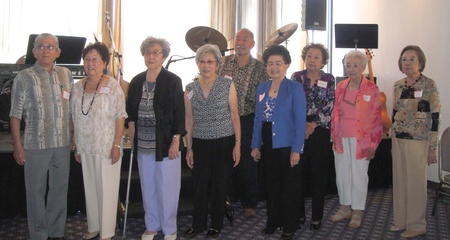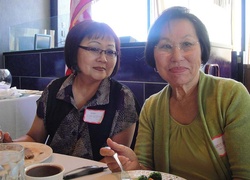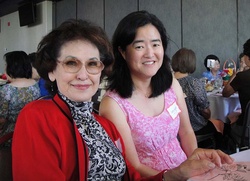On a hot sunny recent Saturday, The Nikkei Widowed Group of Los Angeles held its thirty-second annual installation luncheon. About 120 smartly dressed Nisei members, both widows and widowers, filled the VIP room of the Quiet Cannon Restaurant in Montebello, California for an annual ritual that takes hours of planning and countless board and committee meetings.
The planning showed; the event unfurled with military precision. From 11 to 11:50 a.m., members—most in their 70s and 80s—and guests checked in at the registration table and obtained name tags, just as the program said it would. When my sister, brother and I strolled in little after 11:30 a.m., as guests of our mother, a stir of consternation about our “lateness” seemed to subside, and we had time to meet and mingle with a few of our mothers’ friends.
There was Helen Miyamoto, who as a fellow fourth grader, played dolls with my mother in the Heart Mountain concentration camp. “Your mother had the dishes, and I had the dolls,” Mrs. Miyamoto told me. My mother was lucky to have those doll-sized dishes, since her family could only bring as many belongings as they could carry themselves to Heart Mountain. But a loyal Filipino employee at her parent’s store in downtown L.A. kindly packed up a box of her toys, and sent them on to the family at Heart Mountain. “I still remember opening up that box and seeing all my toys,” my mother told me. It must have felt like Christmas amid the barebones setting of barracks, dust and tumbleweeds.
Mrs. Miyamoto had been driven to the luncheon from Santa Ana by her friend Michiko Dohi, her sprightly looking companion. At 84, Mrs. Dohi “drives all over the place” with ease, Mrs. Miyamoto said proudly. We also met Yuki Yamashita, who had been on the popular NWG field trip to the home of famed furniture maker Sam Maloof in Alta Loma, and Mas Matoi, a former travel agent who arranges all of the group’s trips. (Currently in the planning stages: an August visit to the J. Paul Getty Museum followed by lunch at Lawry’s Prime Rib, for only $62, including the bus driver’s tip!)
At the stroke of noon, Mistress of Ceremonies Gladys Itamura took to the podium to offer some warm words of welcome. Member Paul Fujimoto was up next, to lead members in the Pledge of Allegiance. He asked everyone to please stand, and put their hand over their heart. “Ready, begin,” he said, and then launched into the pledge. I had trouble remembering the words, as the last time I had pledged allegiance to the flag was in a California public school many years ago. The NWG members, on the other hand, pledged with ease and confidence.
Next, the Rev. Karen Fay Ramos-Young led a moment of silent prayer and meditation in memory of the members who had passed away during the past year, Eiko Nomura, Kay Seno, Fumi Tamura, James Oka and Rae Naritomi. The passing of members has taken a toll on NWG membership, my mother told me. Where at one time a gala luncheon such as this might have attracted upwards of 150 members, and more than 200 at their Christmas banquet…those days are no more. Membership in the club has fallen from a peak of 168 in 2003 to 130 today.
MC Itamura returned to the podium to introduce Honored Guests, who included Gwen Muranaka, editor of the Rafu Shimpo and Rev. Ramos-Young, among others. By then it was 12:08 p.m. “Lunch will be served at 12:10,” MC Itamura announced.
As waiters delivered baskets of rolls and plates of salad, with our choice of honey mustard or ranch dressing, MC Itamura, who was sitting at our table and is a former school nursing administrator, passed around a bottle of hand sanitizer. The chat turned to the Rafu Shimpo, and the secret identity of the writer of my favorite column, “Tangoro,” which explains both the modern and ancient usage and meaning of a single Japanese word. Code-named “Rafuko,” Muranaka revealed that the column’s writer is reporter and UCLA Japanese instructor Ryoko Onishi.
Itamura told us about her family: four children, six grandchildren (“two are bonus, because my son married someone with two children”), her former career, and her book discussion group at the Montebello Public Library, which is now reading a novel about an esteemed woman, a Harvard professor, who is diagnosed with early-onset Alzheimer’s disease. The good thing about retirement, Itamura told us, is that “you can do a lot that you never had time for before,” though she still keeps her nursing license active just in case.
The quiet, conversational murmur that settled over the room as NWG members ate their first course and chatted seemed somehow more subdued and polite than your average banquet-style luncheon. To my left, my sister was deep in discussion with Mrs. Chris Uiru, Muranaka’s step-mother. Her grandfather, Seiroku Watanabe, was an adventurer who traveled through Mexico before starting the well-known Watanabe Nursery at Western and Exposition Avenues, in what was known as the Seinan neighborhood of Southwest L.A.
© 2011 Nancy Matsumoto









